seat adjustment AUDI A4 2015 Owners Manual
[x] Cancel search | Manufacturer: AUDI, Model Year: 2015, Model line: A4, Model: AUDI A4 2015Pages: 304, PDF Size: 74.86 MB
Page 62 of 304

60 Seats and stor age
Seats and storage
General recommen
dations
Why is your seat adjustment so
important?
The safety belts and the airbag system can
only provide maximum protection if the front
seats are correctly adjusted.
There are various ways of adjusting the front
seats to provide safe and comfortable support
for the driver and the front passenger. Adjust
you r seat prope rly so that :
- you can easily and quickly reach all the
switches and controls in the instrument
panel
-your body is properly supported thus reduc
ing physical stress and fatigue
- the safety be lts and airbag system can offer
maximum protection ¢
page 144.
In the following sections, you will see exactly
how you can best adjust your seats .
There are special regulations and instructions
for installing a child safety seat on the front
passenger's seat. Always follow the informa
tion regarding child safety provided in
¢ page 165, Child Safety.
WARNING
Refer to¢ page 126, Driving Safely for
important information, tips, suggestions
and warnings that you should read and fol
low for your own safety and the safety of
your passengers.
A WARNING
, -
Incorrect seating position of the driver and
all other passengers can result in serious
personal injury .
- Always keep your feet on the floor when
the vehicle is in motion -never put your
feet on top of the instrument panel, out of the w indow or on top of the seat cush
ion. This applies especially to the passen- gers
. If your seating position is incorrect,
you increase the risk of injury in the case
of sudden braking or an accident. If the
airbag inflates and the seating position is incorrect, this could result in personal
injury or even death.
- It is important for both the driver and front passenger to keep a distance of at
least 10 inches (25 cm) between them
selves and the steering wheel and/or in
strument panel.
If you're sitting any
closer than this, the airbag system can
not protect you properly. In addition, the
front seats and head restraints must be
adjusted to your body height so that they
can give you maximum protection.
- Always try to keep as much distance as
possible between yourself and the steer
ing wheel or instrument panel.
- Do not adjust the driver's or front pas
senger 's seat while the vehicle is moving.
Your seat may move unexpectedly, caus
ing sudden loss of veh icle control and
personal injury. If you adjust your seat
while the veh icle is moving, you are out
of posit ion.
Driver's seat
The correct seat position is important for safe
and relaxed driving .
We recommend that you adjust the driver's
seat in the following manner :
.. Adjust the seat in fore and aft direction so
that you can easily push the pedals to the
floor wh ile keeping your knees slightly bent
o &. in Why is your seat adjustment so im
portant? on page
60 .
.,. Adjust the seatback so that when you sit
w ith your back against the seatback , you can
still grasp the top of the steering wheel.
.. Applies to vehicles with adjustable head re
straints: Adjust the head restraint so the up
per edge is as even as possible with the top
of your head. If that is not possible, try to
adjust the head restraint so that it is as .,.
Page 63 of 304
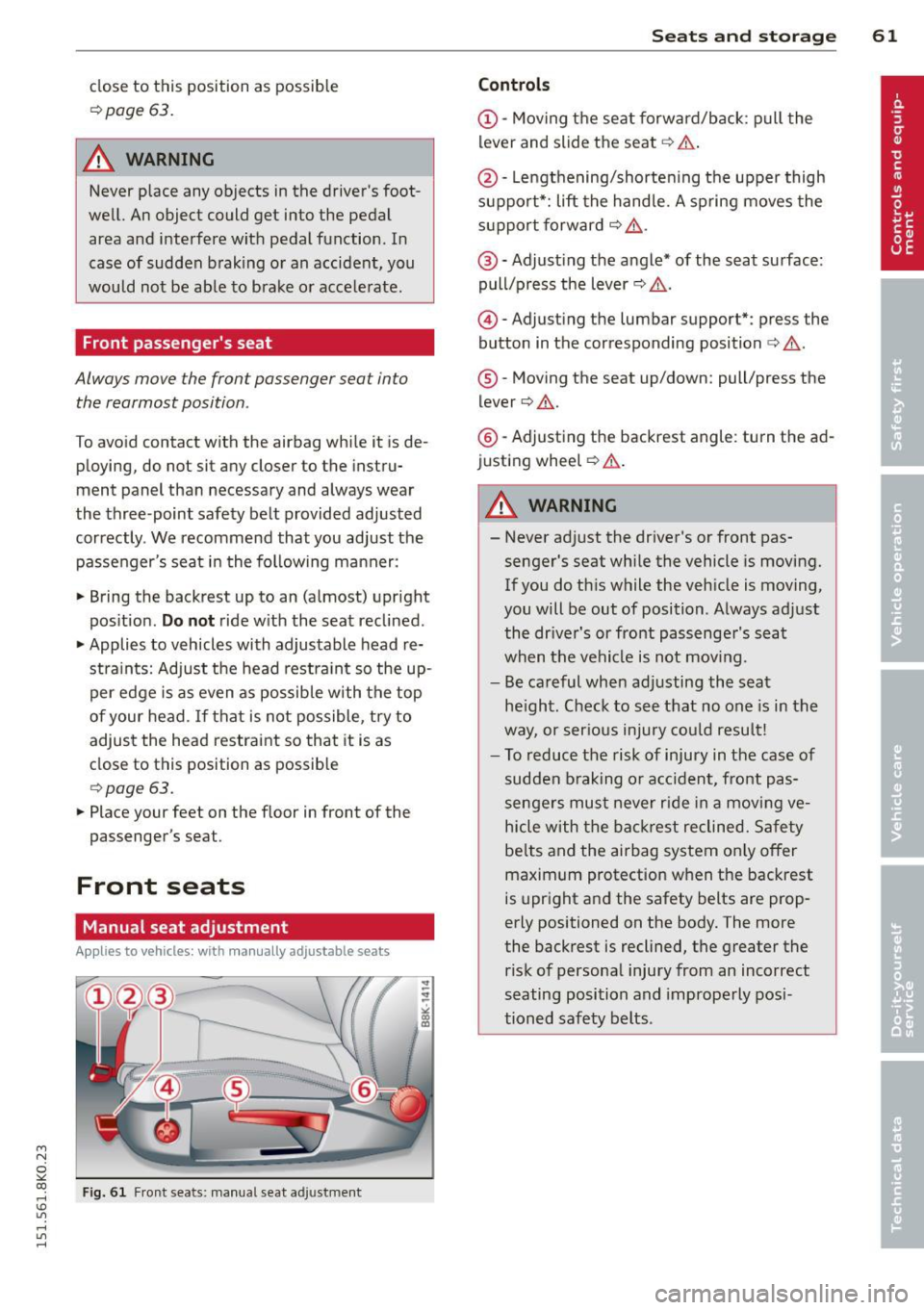
M N
~ co
rl I.O
"' rl
"' rl
close to this position as possible
c:>page 63.
A WARNING
Never place any objects in the driver's foot
well. An object could get into the pedal
area and interfere with pedal function. In
case of sudden braking or an accident, you
would not be able to brake or accelerate .
Front passenger's seat
Always move the front passenger seat into
the rearmost position .
To avoid contact with the airbag while it is de
ploying, do not sit any closer to the instru
ment panel than necessary and always wear
the three-point safety belt provided adjusted
correctly . We recommend that you adjust the
passenger's seat in the following manner:
.,. Bring the backrest up to an (almost) upright
position.
Do not ride with the seat reclined .
"" Applies to vehicles with adjustable head re
stra ints: Adjust the head restraint so the up
per edge is as even as possible with the top
of your head. If that is not possible, try to
adjust the head restraint so that it is as
close to this position as possible
c:> page 63.
.,. Place your feet on the floor in front of the
passenger's seat .
Front seats
Manual seat adjustment
Appl ies to vehicles: with manu ally a djustable seats
Fig. 61 Fr ont seats: manual seat adjustment
Seats and storage 61
Controls
@-Moving the seat forward/back: pull the
lever and slide the seat
c:> A.
@ -Lengthening/shortening the upper thigh
support*: lift the handle. A spring moves the
support forward
c:> ,& .
@ -Adjust ing the angle* of the seat surface:
pull/press the lever
c:> ,& .
@) -Adjusting the lumbar support*: press the
button in the corresponding position
c:> ,& .
®-Moving the seat up/down: pull/press the
lever
c:> .&. .
@ -Adjusting the backrest angle : turn the ad
justing wheel
c:> .&..
A WARNING ,--
-Never adjust the driver's or front pas
senger's seat while the vehicle is moving.
If you do this while the veh icle is moving,
you will be out of position. Always adjust
the dr iver's or front passenger's seat
when the vehicle is not mov ing.
- Be careful when adjusting the seat
he ight. Check to see that no one is in the
way, or ser ious injury could result!
- To reduce the risk of injury in the case of
sudden braking or accident, front pas
sengers must never rid e in a moving ve
hicle with the backrest reclined. Safety
be lts and the airbag system on ly offer
maximum protection when the backrest
is upright and the safety belts are prop
erly positioned on the body. The more
the backrest is reclined, the greater the
risk of personal injury from an incorrect
seating position and improperly posi
tioned safety belts.
Page 64 of 304
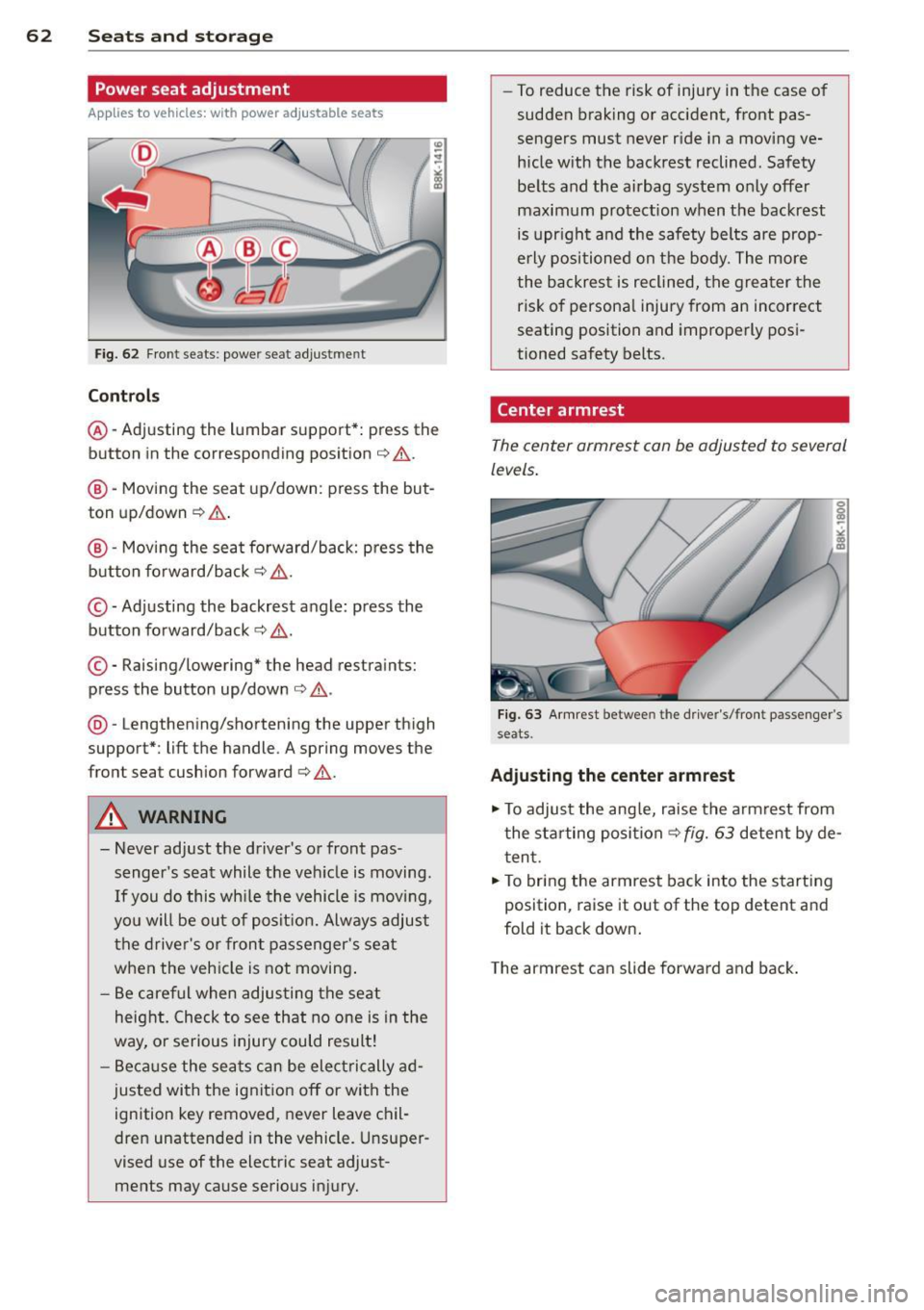
62 Seats and storage
Power seat adjustment
App lies to vehicles: with power adjustable seats
Fig. 62 Front seats: powe r seat adjust men t
Contr ols
@ -Adj usting the lumbar support*: press the
button in the corresponding position ¢.&. .
@ -Moving the seat up/down: press the but
ton up/down ¢.&. .
@ -Moving the seat forward/back: p ress the
button fo rward/back
¢ & .
©-Adjusting the backrest angle: press the
button fo rward/back
¢ & .
©-Raising/lowering* the head restraints:
press the button up/down ¢ .&. .
@ -Lengthening/shortening the upper thigh
support*: lift the handle. A spring moves the
front seat cushion forward¢& .
A WARNING
- Never adjust the d river's or front pas
senger 's seat while the veh icle is moving .
If you do this wh ile the vehicle is movi ng,
yo u will be out of posit ion. Always adjus t
the drive r's or front passenger's seat
when the vehicle is not moving .
- Be care ful when adjus ting the seat
heig ht. Check to see that no one is in the
way, o r serious injury could result!
- B eca use the sea ts can be elec trically ad
justed with the ignit ion off or with the
ignition key removed, never leave chil
dren unattended in the vehicle. Unsuper
vised use of the electric seat adjust ments may cause serious injury. -
To reduce the risk of injury in the case of
sudden braking or accident, front pas
sengers must never r ide in a moving ve
hicle with the backrest reclined . Safety
be lts and the airbag system only offer
maximum protection when the backrest is upr ight and the safety belts are prop
e rly po sit ioned on the body. The more
the backres t is reclined, the grea ter the
risk of persona l injury from an incorrect
seating position and imprope rly posi
tioned safety belts.
Center armrest
The center armrest can be adjusted to several
levels .
Fig . 63 A rm rest betwee n the d rive r's/front passenger's
seats.
Ad ju sting the center armrest
"" To adjus t the ang le, raise the armrest from
the starting position
¢ fig. 63 detent by de
t en t.
.,. To bring the armrest back into the starting
position, raise it out of the top detent and
fold it back down.
T he armrest can slide forwar d and back .
Page 65 of 304
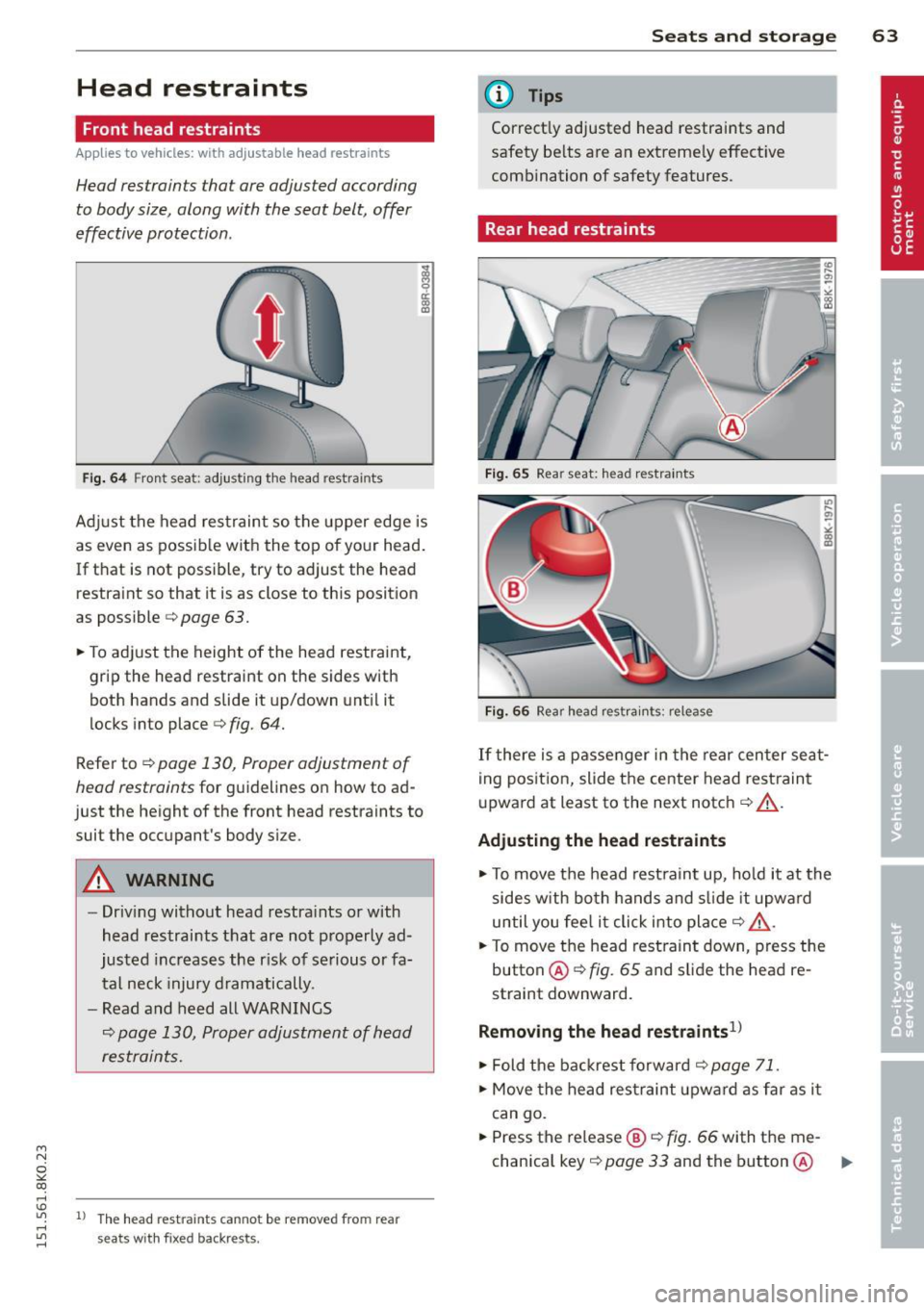
M N
~ co
rl I.O
Head restraints
Front head restraints
Applies to vehicles: with adj ustable head restraints
Head restraints that are adjusted according
to body size, along with the seat belt , offer
effective protection .
Fig. 64 Fron t seat: adjusting the head rest ra in ts
Ad just the head restraint so the upper edge is
as even as possible with the top of your head.
If that is not poss ible, try to adjust the head
restraint so that it is as close to this position
as possible
¢ page 63.
~ To adjust the height of the head restraint,
grip the head restraint on the sides with
both hands and slide it up/down until it
locks into place
¢fig. 64.
Refer to ¢ page 130, Proper adjustment of
head restraints
for guidelines on how to ad
just the height of the front head restraints to
suit the occupant's body size .
A WARNING
-Driving without head restra ints or with
head restraints that are not properly ad
justed increases the r isk of serious or fa
tal neck injury dramatically.
- Read and heed all WARNINGS
¢ page 130, Proper adjustment of head
restraints.
-
"' l) The head restra ints cann ot be re move d fro m rear rl
~ seats with fixe d backr ests.
Seats and storage 63
@ Tips
Correctly adjusted head restraints and
safety be lts are an extreme ly effective
combination of safety features.
Rear head restraints
Fig. 65 Rear seat: head restraints
Fig. 66 Rear head res train ts : re lease
If there is a passenger in the rear center seat
ing position, slide the center head restraint
upward at least to the next notch¢&_ .
Adjusting the head restraints
~ To move the head restraint up, hold it at the
sides with both hands and slide it upward
until you feel it click into place¢&_ .
~ To move the head restraint down, press the
button @¢
fig. 65 and slide the head re
straint downward .
Removing the head restraints1>
~ Fold the backrest forward¢ page 71.
~ Move the head restraint upwa rd as far as it
can go.
~ Press the release@¢ fig. 66 with the me-
chanical key ¢
page 33 and the button @ ..,.
Page 66 of 304
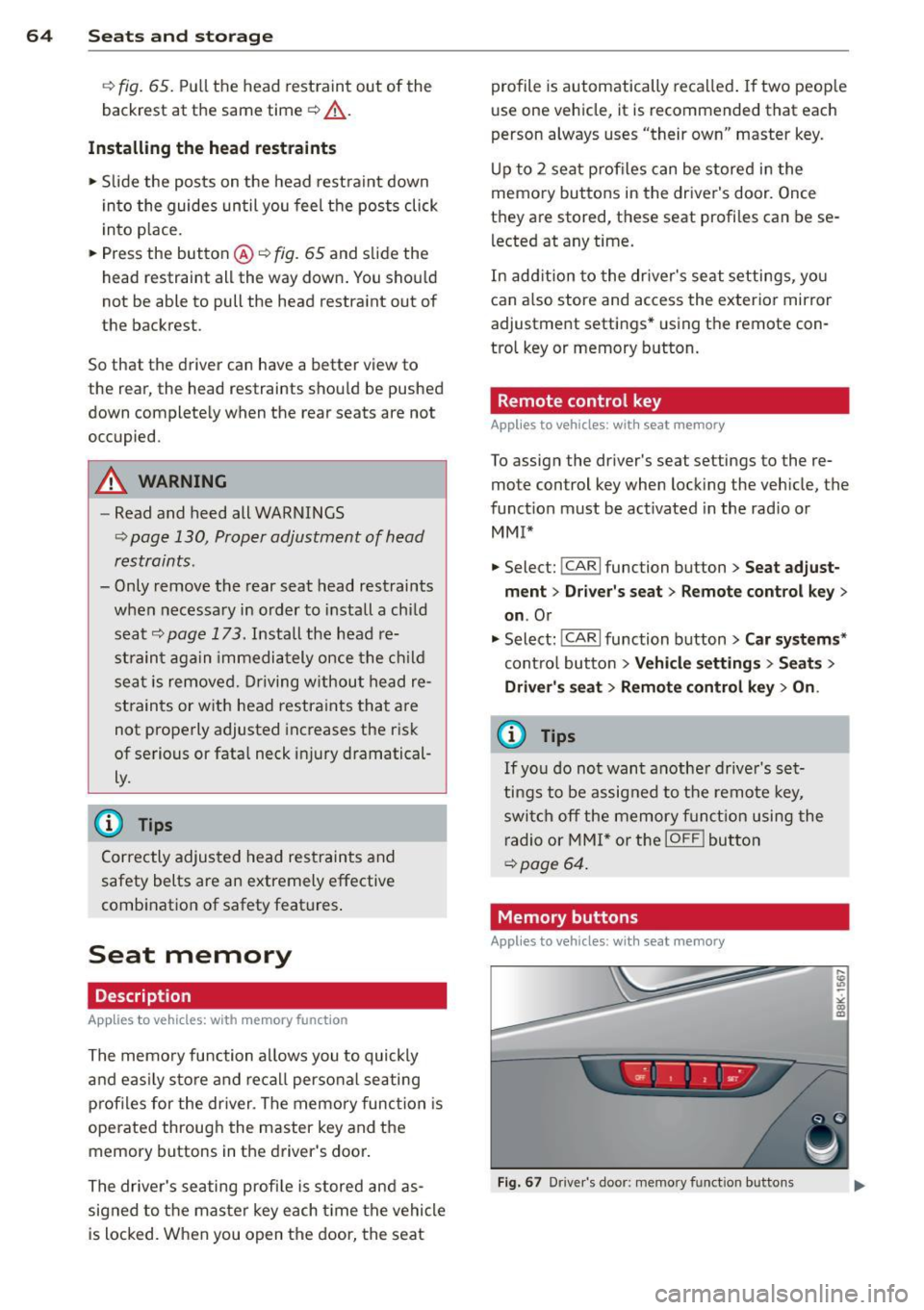
64 Seats and storage
¢ fig. 65. Pull the head restraint out of the
backrest at the same time¢,&. .
Installing the head restraints
.. Slide the posts on the head restraint down
into the guides until you feel the posts click
i nto place.
.. Press the button@¢
fig. 65 and slide the
head restraint all the way down. You should
not be able to pull the head restraint out of
the backrest.
So that the driver can have a better view to
the rear, the head restraints should be pushed
down completely when the rear seats are not
occupied .
A WARNING ,.
- Read and heed all WARNINGS
¢ page 130, Proper adjustment of head
restraints .
- Only remove the rear seat head restraints
when necessary in order to install a child
seat¢
page 173. Install the head re
straint again immediately once the child
seat is removed. Driving without head re
straints or with head restraints that are
not properly adjusted increases the risk
of serious or fatal neck injury dramatical
ly.
@ Tips
Correctly adjusted head restraints and
safety belts are an extremely effective
combination of safety features .
Seat memory
Description
Applies to vehicles: with memory function
The memory function allows you to quickly
and easily store and recall personal seating
profiles for the dr iver . The memory function is
operated through the master key and the memory buttons in the driver's door.
The driver's seating profi le is stored and as
signed to the master key each time the vehicle
is locked. When you open the door, the seat profile is
automatically recalled.
If two people
use one vehicle, it is recommended that each
person always uses "their own" master key.
Up to 2 seat profiles can be stored in the
memory buttons in the driver's door. Once
they are stored, these seat profiles can be se
lected at any time .
In addition to the driver's seat settings, you
can also store and access the exterior mirror
adjustment settings* using the remote con
trol key or memory button.
Remote control key
Applies to vehicles: wit h seat memory
To assign the driver's seat settings to the re
mote control key when locking the vehicle, the
function must be activated in the rad io or
MMI*
.. Select: !CAR I function button> Seat adjust
ment
> Driver's seat > Remote control key >
on.Or
.. Select: !CARI function button> Car systems*
control button > Vehicle settings > Seats >
Driver' s seat> Remote control key> On .
(i) Tips
If you do not want another driver's set
tings to be assigned to the remote key,
switch off the memory function using the
radio or MMI* or the
IOFFI button
¢page 64.
Memory buttons
Applies to vehicles: with seat memory
Fig. 67 Dr iver's door: memo ry fu nct ion buttons
Page 67 of 304

M N
~ co
rl I.O
"' rl
"' rl
The memory buttons are located in the driv
er's door.
Switching the memory function on/off
• Press the !OFF ! button to switch the memory
function on/off. The word
OFF lights up
when the memory function is switched off.
Seat profiles are neither stored nor recalled.
Storing a seat profile
• Press the !SET ! button. When the word SET
lights up, the memory is ready to store set
t in gs.
• Press a memory button
([II or rn) briefly. A
tone confirms that the settings were stored.
Accessing a seat profile
• If the driver's door is open and the ignition
is switched off, press the memory button.
• If the driver's door is closed or the ignition is
switched on, press and hold the memory
button until the seat adjustment is com
plete .
A WARNING
-For safety reasons, the seat sett ing can
only be recalled when the vehicle is sta
tionary - otherwise you risk having an ac
c ident.
- In an emergency the recall procedure can
be cancelled by press ing the
!OF F! switch
or by tapping the memory buttons.
Ashtray
Fig . 68 Center console: ashtray
Seats and storage 65
Opening/closing
• To open the ashtray, slide the cover up
~fig. 68.
• To close the ashtray, press down on the cov
er .
Emptying the ashtray
• To remove the insert, slide the latch to the
right~fig. 68-arrow-.
• To instal l the insert, press it down into the
mount.
A WARNING
Never put waste paper in the ashtray. Hot
ashes or other hot objects in the ashtray
could set waste paper on fire.
Cigarette lighter
Fig. 69 Front center console: cigar ette lighter
• Press the cigarette lighter in.
• Remove the cigarette lighter when it pops
out .
T he cigarette lighter should only be used as a
power source for the compressor from the in
flatable spare kit* when absol ute ly necessary.
A WARNING
The cigarette lighter on ly works when the
ignition is switched on. Incorrect usage
can lead to serious injuries or burns. For
this reason, children should never be left unattended in the vehicle because this in
creases the risk of injury.
Page 132 of 304
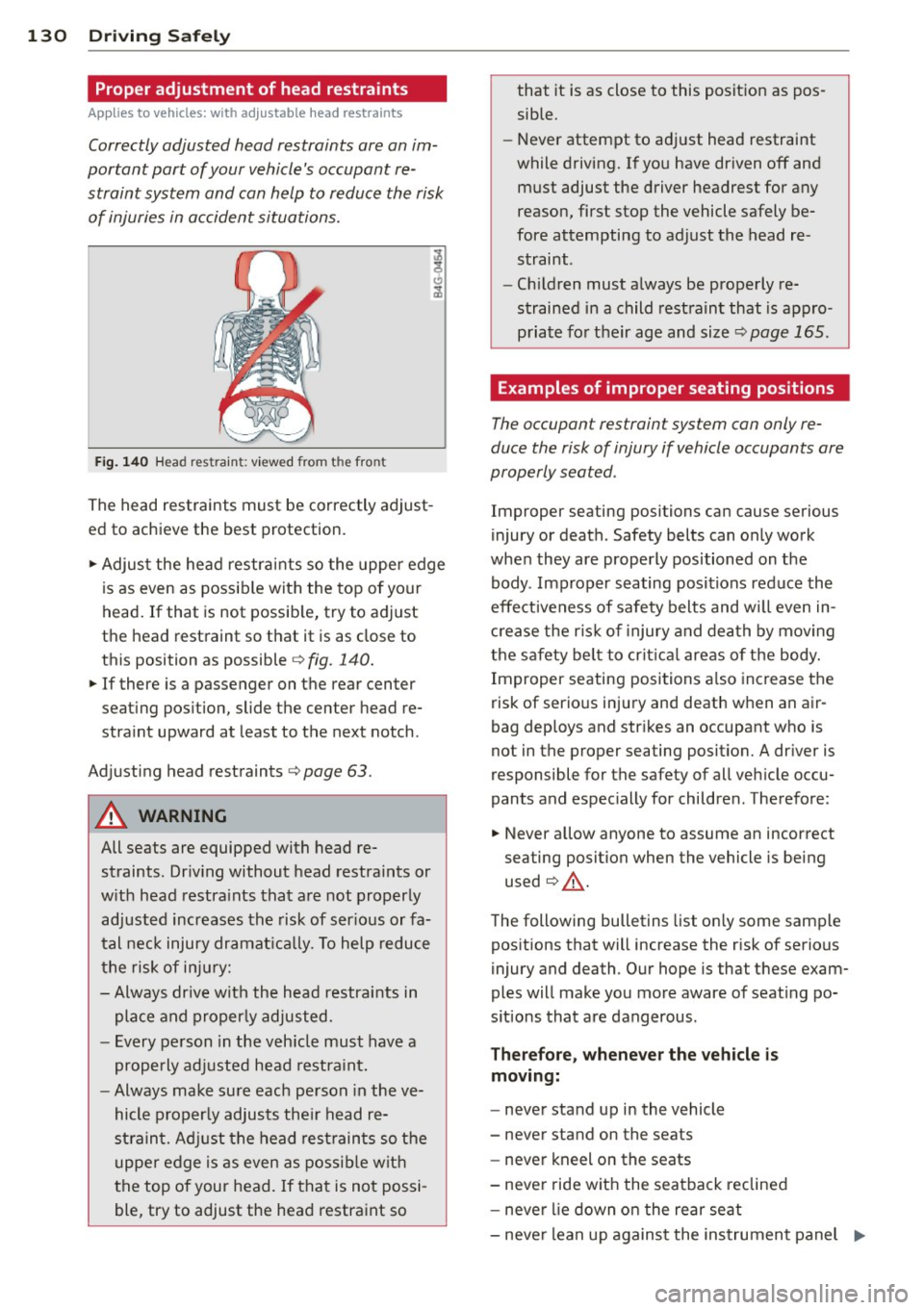
130 Driving Saf ely
Proper adjustment of head restraints
Appl ies to vehicles: with a djustable head restra ints
Correctly adjusted head restraints are an im
portant part of your vehicle's occupant re
straint system and can help to reduce the risk of injuries in accident situations.
F ig . 14 0 Head restrain t: viewed from the front
The head restraints must be correctly adjust
ed to achieve the best protection.
• Adjust the head restraints so the uppe r edge
is as even as possible with the top of your
head. If that is not possib le, try to adjust
the head restraint so that it is as close to
this position as possible
c:> fig. 140.
• If there is a passenger on the rear center
seat ing pos ition, slide the center head re
stra int upward at least to the next notch .
Ad justing head restraints
<:>page 63.
A WARNING
All seats are equipped with head re
straints. Dr iv ing without head restraints or
w ith head restra ints that are not properly
adjusted increases the risk of ser ious or fa
t al nec k injury dramat ica lly. To help reduce
t he risk of inju ry:
- Always drive with the head restra ints in
place and properly adjusted.
- Every pe rson in the veh icle must have a
properly adjusted head restra int.
- Always make sure each pe rson in the ve
hicle properly adjusts the ir head re
stra int. Adjust the head rest raints so the
upper edge is as even as possib le with
the top of your head. If that is not possi
ble, try to adjust the head restra int so that
it is as close to this posit ion as pos
sible.
- Never attempt to ad just head restraint
while driving. If you have driven off and
must adjust the driver headrest for any
reason, first stop the vehicle safely be
fore attempting to adjust the head re
straint.
- Chil dren must a lways be prope rly re
strained in a child restraint that is appro
p ria te fo r their age and size
c:> page 165.
Examples of improper seating positions
The occupant restraint system can only re
duce the risk of injury if vehicle occupants are
properly seated.
Improper seating positions can cause serious
injury or death. Safety belts can only work
when they are properly positioned on the
body . Improper seating positions reduce the
effectiveness of safety belts and w ill even in
c rease the r is k of i njury and dea th by moving
the safety be lt to cr itical are as of the body.
Improper seating posi tions a lso increase the
risk of serio us injury and death when an air
bag deploys and str ikes an occupant who is
not in the proper seating posit ion. A dr iver is
responsible for the safety of all veh icle occu
pants and espec ially for children. Therefore :
• Never allow anyone to assume an incorrect
seating position when the vehicle is being
used
c:> ,& .
The following bulletins list on ly some samp le
pos itions that will increase the risk of serious
injury and death. Our hope is that these exam
ples will make you more aware of seat ing po
s itions that are dangerous .
Therefore, whenever the vehicle is
moving:
- neve r stand up i n the vehicle
- never stand on the seats
- never kneel on the seats
- never ride wit h the sea tback reclined
- neve r lie down o n the rear seat
- neve r lean up against the instrument panel ..,.
Page 142 of 304

140 Safety belts
To provide maximum protection, safety belts must always be positioned correctly on the
wearer 's body .
.,. Adjust the front seat and head restraint
properly ¢
page 60, Seats and storage .
.,. Make sure the seatback of the rear seat
bench is in an upright position and securely
latched in place befo re using the belt¢.&, .
.,. Hold the belt by the tongue and pull it even-
ly across the chest and pelvis¢.&, .
.,. Insert the tongue into the correct buckle of
your seat until you hear it latch securely
¢fig . 148.
.,. Pull on the belt to make sure that it is se-
curely latched in the buckle .
Automatic safety belt retractors
Every safety belt is equipped with an automat
ic belt retractor on the shoulder belt . This fea
ture locks the belt when the belt is pulled out
fast, during hard braking and in an accident.
The belt may also lock when you drive up or
down a steep hill or through a sharp curve. During normal driving the belt lets you move
freely .
Safety belt pretensioners
The safety belts are equipped with a be lt pre
tensioner that helps to tighten the safety belt
and remove slack when the pretensioner is ac
tivated. The function of the pretensioner is
monitored by a warning light¢
page 20 .
Convertible locking retractor
Every safety belt except the one on the driver
seat is equipped with a convertible locking re
tractor that
must be used when the safety
belt is used to attach a child safety seat. Be
sure to read the important information about
this feature ¢
page 175.
A WARNING
Improperly positioned safety belts can
cause serious injury in an accident
¢ page 140, Safety belt position.
- Safety belts offer optimum protection
only when the seatback is upright and
-
belts are properly positioned on the
body.
- Always make sure that the rear seat
backrest to which the center rear safety
belt is attached is securely latched when
ever the rear center safety belt is being
used. If the backrest is not securely
latched, the passenger w ill move for
ward with the backrest during sudden
braking, in a sudden maneuver and espe
cially in a crash .
- Never attach the safety belt to the buck
le for another seat. Attaching the belt to
the wrong buckle will reduce safety belt
effectiveness and can cause serious per
sonal injury.
- A passenger who is not properly restrain
ed can be seriously injured by the safety
belt itself when it moves from the stron
ger parts of the body into critical areas
like the abdomen .
- Always lock the convertible locking re
tractor when you are securing a child
safety seat in the vehicle
c:> page 177.
Safety belt position
Correct belt position is the key to gett ing
maximum protection from safety belts.
Fig. 149 Safety bel t position
Standard features on your vehicle help you ad
just the position of the safety belt to match
your body size.
- belt height adjustment for the front seats,
- automatic belt height adjustment for the
rear seats .
Page 146 of 304
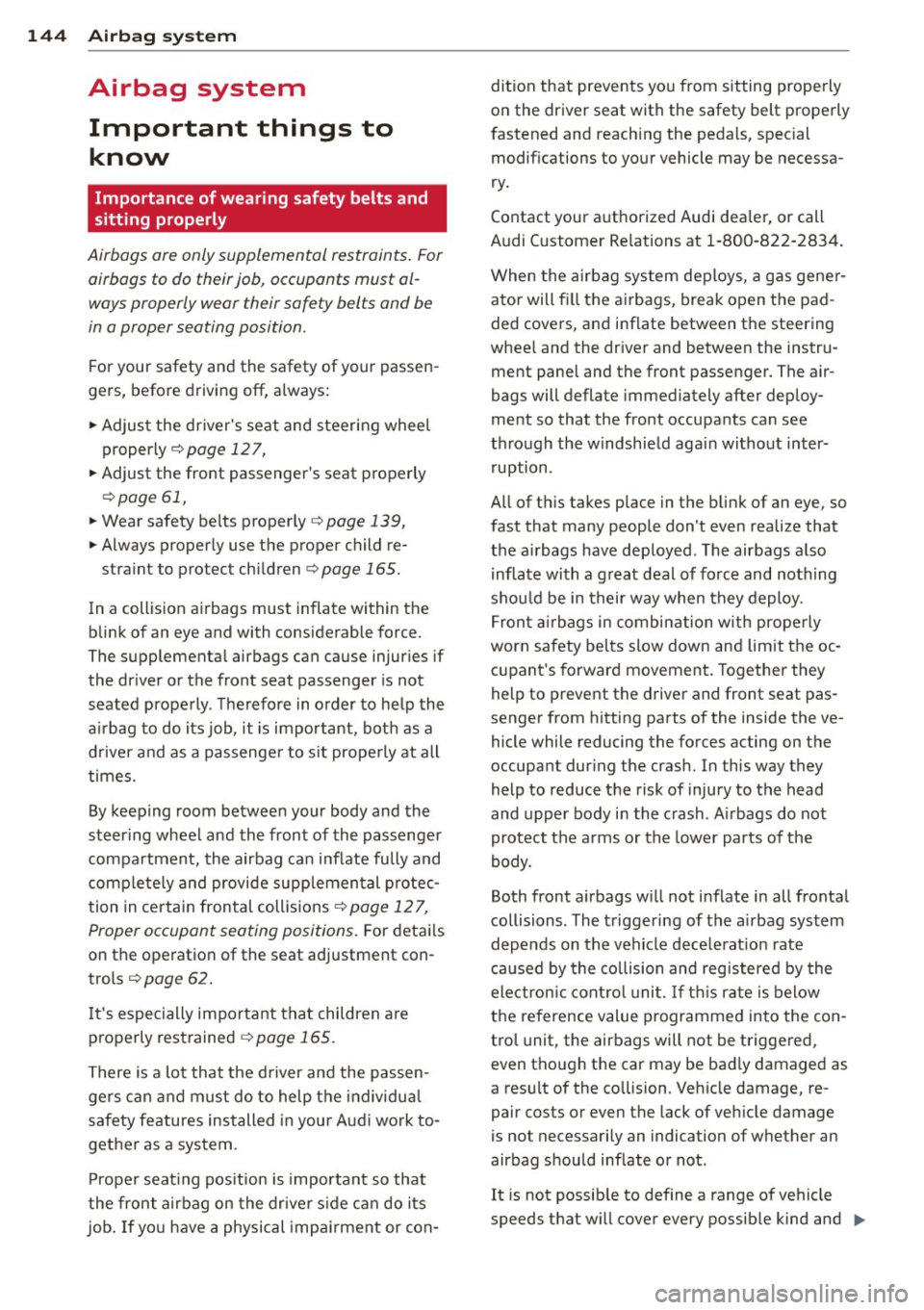
144 Airbag system
Airbag system
Important things to know
Importance of wearing safety belts and
sitting properly
Airbags are only supplemental restraints. For
airbags to do their job , occupants must al
ways properly wear their safety belts and be
in a proper seating position.
F or your safety and the safety of your passen
gers, before driving off, always:
• Adjust the driver's seat and steering wheel
properly
¢ page 127,
• Adjust the front passenger's seat properly
r=; page 61,
• Wear safety be lts properly ¢ page 139,
• Always properly use the proper child re-
straint to protect children¢
page 165.
In a collision airbags must inflate within the
blink of an eye and with considerable force.
The supplemental airbags can cause injuries if
the dr iver or the front seat passenger is not
seated properly . Therefore in order to help the
a ir bag to do its job, it is important, both as a
d river and as a passenger to sit prope rly at all
times.
By keeping room between your body and the
steering wheel and the front of the passenger
compartment, the airbag can inflate fully and
comp letely and provide supplemental protec
tion in ce rtain frontal collisions
¢page 127,
Proper occupant seating positions.
F or details
on the operation of the seat adjustment con
t rols ¢
page 62.
It's especially important that children are
properly restrained
r=:;page 165.
There is a lot that the driver and the passen
ge rs can and must do to help the individua l
safety features installed in your A udi work to
gether as a system.
Proper seating pos ition is important so that
the front airbag on the driver side can do its
job. If yo u have a physical impairment or con- dition that
prevents you from sitting properly
on the driver seat with the safety belt properly
fastened and reaching the pedals , spec ial
modif ications to your vehicle may be necessa
ry.
Contact your authorized Audi dealer, or call
Audi C ustomer Relations at 1-800-822-2834 .
When the airbag system dep loys , a gas gener
ator will f ill the airbags, break open the pad
ded covers, and inflate between the steering
whee l and the dr iver and between the instru
ment panel and the front passenger. The air
bags will deflate immediately after deploy
ment so that the front occupants can see
th rough the windshield aga in without inter
ruption .
All of this takes place in the blink of an eye , so
fast that many people don't even realize that
the a irbags have deployed . The airbags also
inflate with a great deal of force and nothing
shou ld be in their way when they deploy.
Front airbags in comb ination with prope rly
worn safety belts slow down and limit the oc
cupant's forward movement. Together they
help to prevent the driver and front seat pas
senger from hitting parts of the inside the ve
hicle while reducing the forces acting on the
occupant dur ing the crash. In this way they
help to reduce the risk of injury to the head
and upper body in the crash . A irbags do not
protect the arms or the lower parts of the
body.
Both front a irbags w ill not inflate in all fronta l
collisions . The triggering of the airbag system
depends on the vehicle deceleration rate
caused by the collision and registered by the
electron ic control unit. If this rate is below
the reference value programmed into the con
trol unit, the airbags will not be triggered ,
even though the car may be bad ly damaged as
a result of the co llision . Vehicle damage, re
pair costs or even the lack of veh icle damage
is no t necessarily an indication of whether an
airbag should inflate or not .
It is not possib le to define a range of vehicle
speeds that w ill cover every possib le kind and .,.
Page 152 of 304
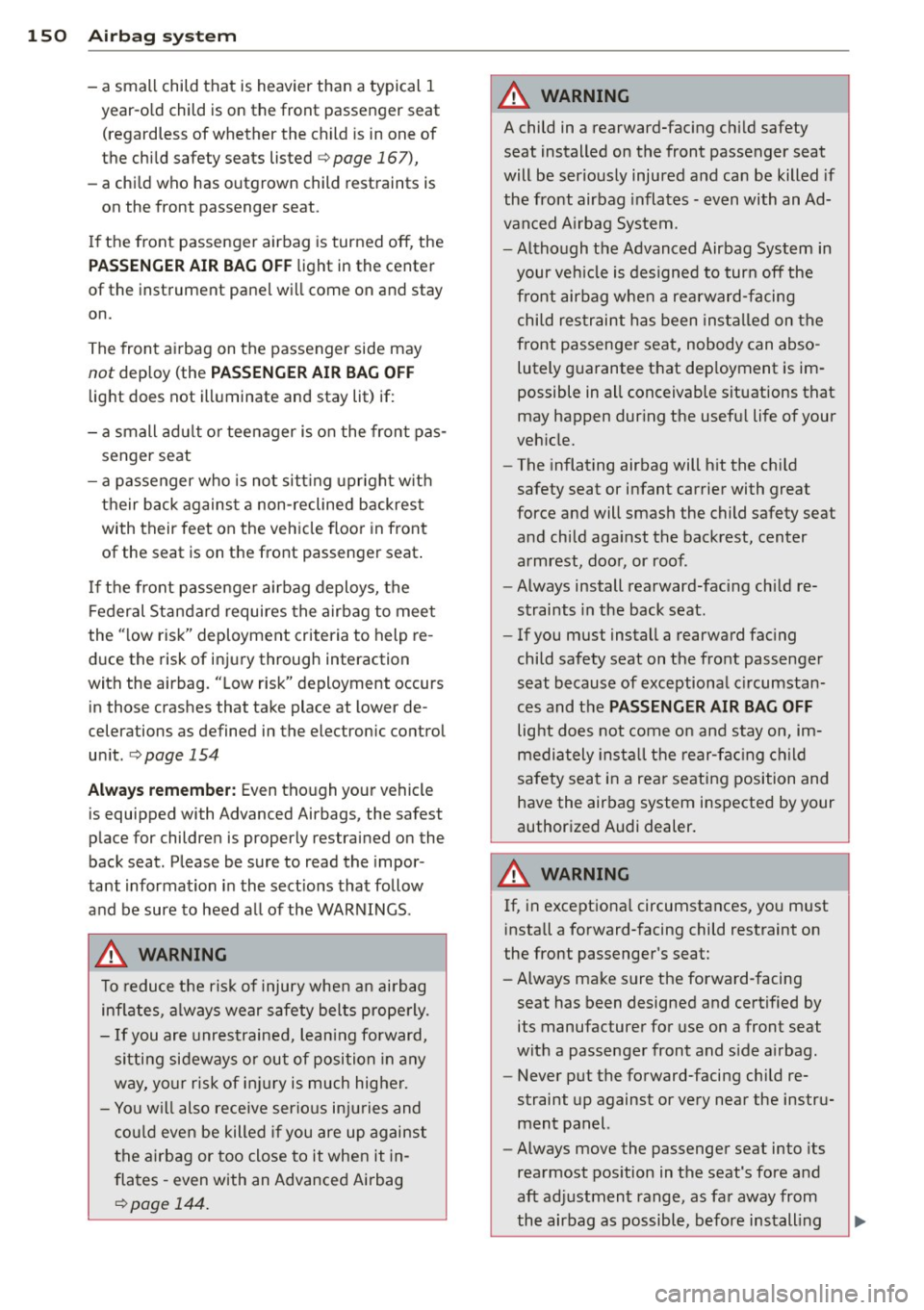
150 Airbag sys te m
- a small child that is heavier than a typical 1
year-o ld child is on the front passenger seat
(regardless of whether the child is in one of
the child safety seats listed
q page 167),
-a chi ld who has outgrown child restraints is
on the front passenger seat.
I f the front passenger airbag is turned off , the
PA SSENGER AIR BAG OFF light in the center
of the instrument panel wi ll come on and stay
on.
The front ai rbag on the passenger side may
not deploy (the PASSENGER A IR BAG OFF
light does not illuminate and stay lit) if:
- a small ad ult or teenager is on the front pas
senger seat
- a passenger who is not sitt ing upr ight w it h
their back against a non-reclined backrest
with their feet on the vehicle floo r in front
of the seat is on the front passenger seat .
I f the front passenge r airbag deploys, the
F ederal Standard requires the airbag to meet
the " low risk" deployment criteria to help re
duce the risk of injury through interact ion
with the airbag. " Low risk" deployment occurs
in those crashes that take place at lower de
celerations as defined in the electronic control
un it .
q page 154
Al way s remember: Even tho ugh your vehicle
is equipped with Advanced Airbags, the safest
p lace for children is properly restrained on the
back seat . Please be sure to read the impor
tant information in the sect ions that follow
and be sure to heed a ll of the WARNINGS .
A WARNING
To reduce the ris k of injury whe n an airbag
inflates, a lways wear safety belts properly.
- If you are unrestrained, lean ing fo rward,
s itting sideways or out of position in any
way, your risk of in jury is much higher.
- You w ill also receive serio us inju ries and
cou ld even be killed if you are up against
the a irbag or too close to it when it in
fla tes - even with an Advanced Airbag
q page 144.
A WARNING
A child in a rearward-fac ing ch ild safety
seat installed on the front passenger seat
will be seriously injured and can be killed if
the front airbag inflates - even with an Ad
van ced A irbag System.
- Altho ugh the Advanced Airbag System in
your veh icle is designed to tur n
off the
front airbag when a rea rward-facing
chi ld res traint has been instal le d on the
front passenger seat, nobody can abso
lutely g uarantee that dep loyment is im
possible in all conceivable situations that
may happen dur ing the usefu l life of your
veh icle.
- The inflating airbag will h it the ch ild
safety seat or infant carrier with great
force and will smash the child safety seat
and chi ld aga inst the backrest, center
armrest, doo r, or roof.
- Always install rearward-facing ch ild re
straints in the back seat.
- If you must install a rearward fac ing
child safety seat on the front passenger
seat because of exceptional c ircumstan
ces and t he
PASSENGER AIR BAG OFF
light does not come on and s tay on, im
mediately inst all the rear -fac ing ch ild
safety seat in a rear seating position and
have the airbag system inspected by your
authorized Audi dealer .
A WARNING
If, in exceptional circumstances, you m ust
i nsta ll a forward-facing child restraint on
the front passenger's seat:
- Always make sure the forward-facing
seat has been designed and certified by its manufacturer for use on a front seat
with a passenger front and s ide a irbag .
- Never p ut the forward-facing child re
straint up against or very near the instru
ment panel.
- Always move the passenger seat into its
rearmost pos ition in the seat's fore and
aft adjustment range, as fa r away from
the airbag as possible, before installing